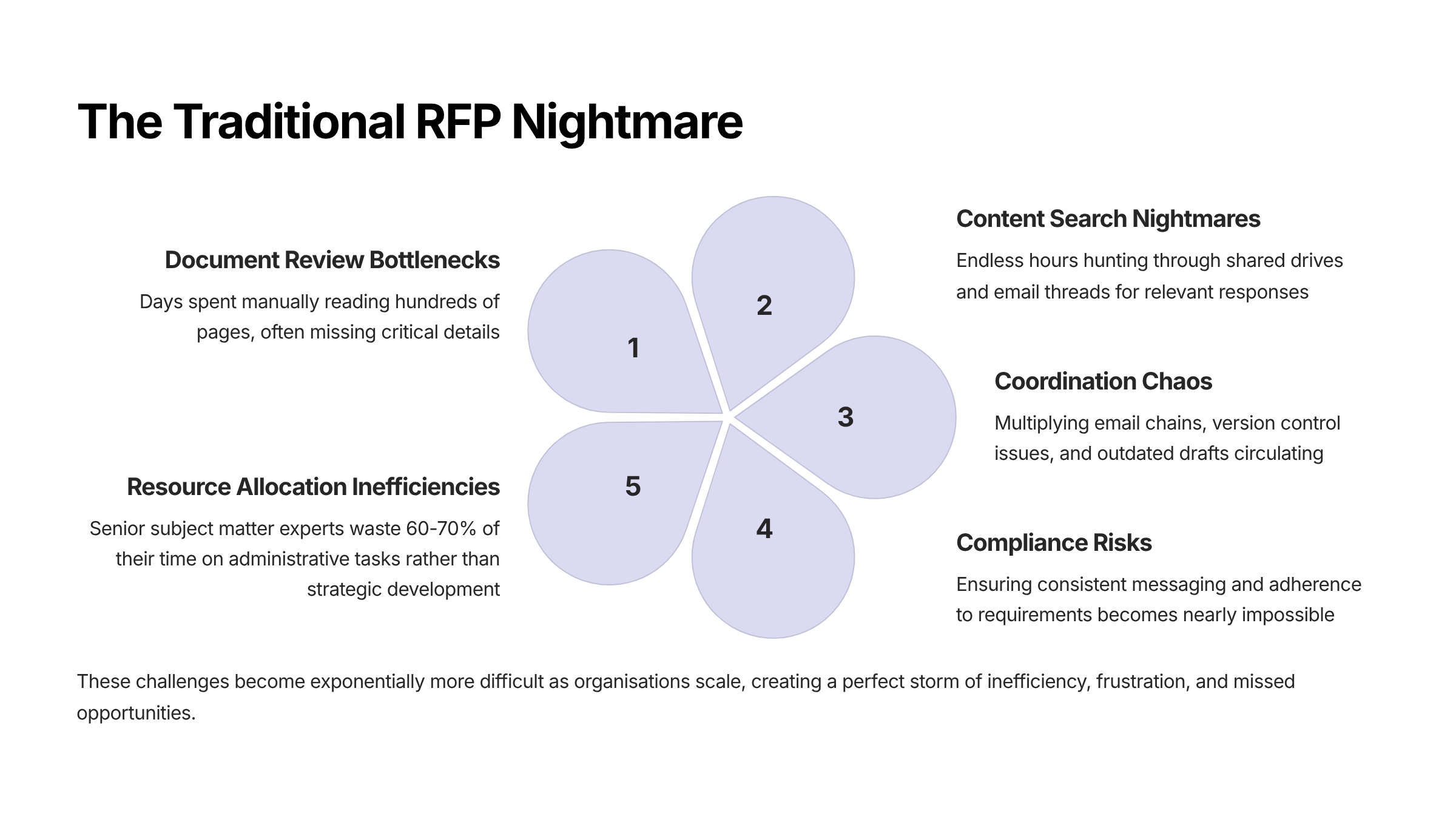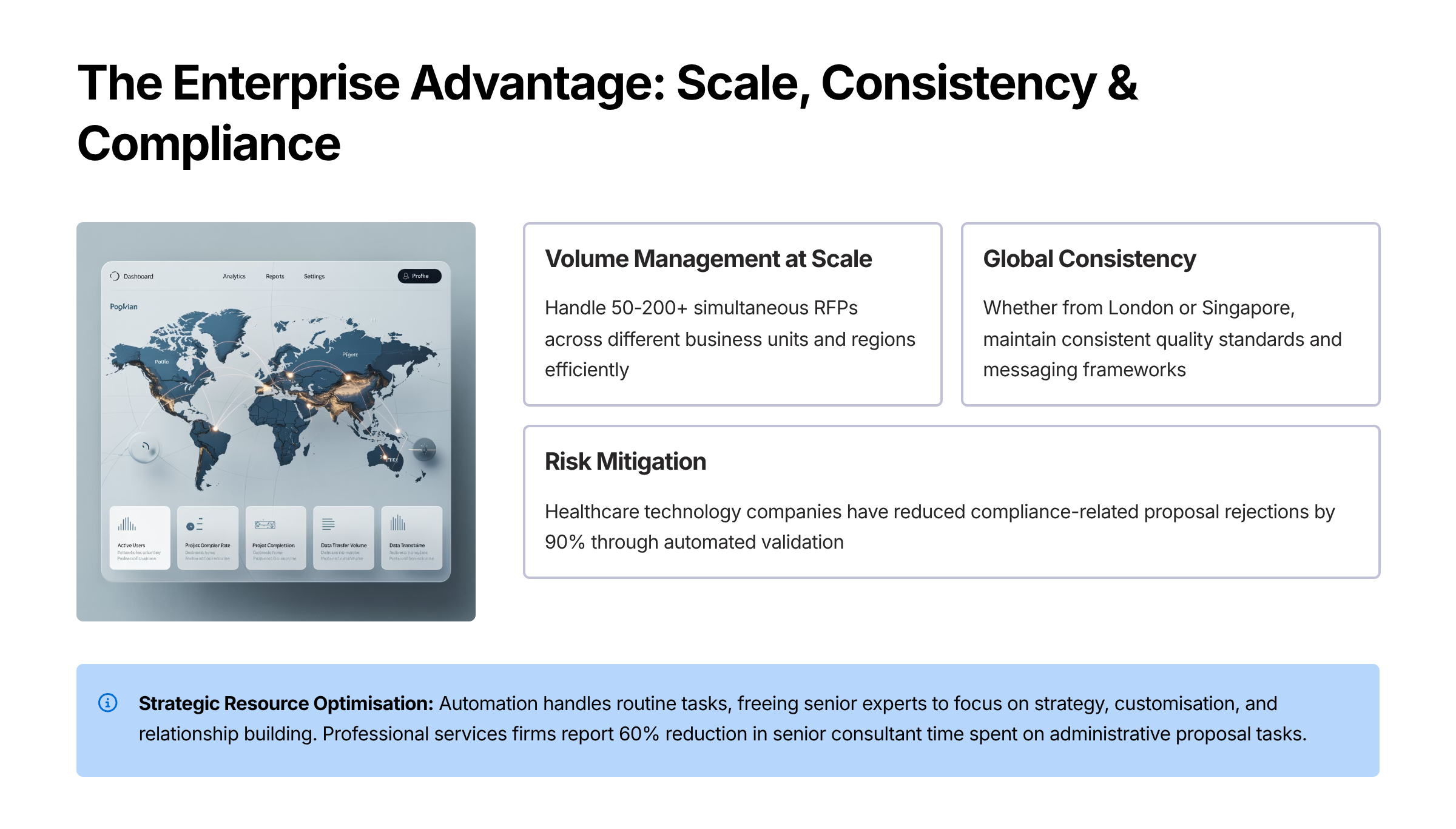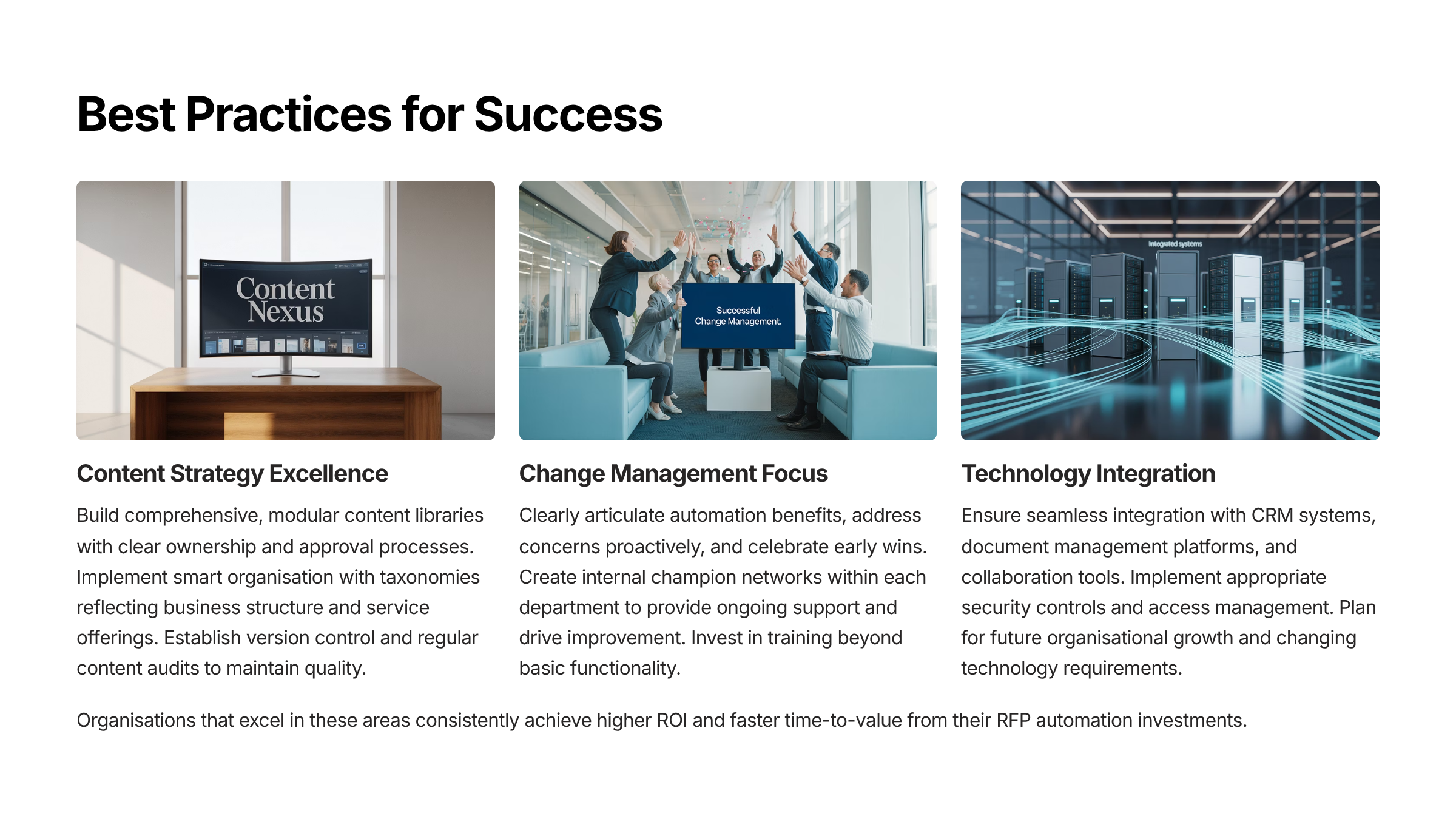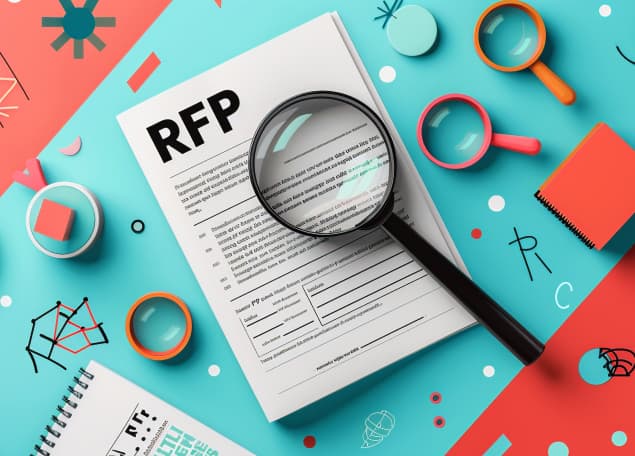How RFP Workflow Automation is Transforming Enterprise Proposal Management in 2025
Article written by
Jeku Jacob Philip

INSIDE THE ARTICLE
SHARE THIS ARTICLE
Summary
Manual RFP workflows create chaos, missed deadlines, and frustrated teams. This blog unpacks how RFP workflow automation brings structure, speed, and clarity—reducing response times by 70% and increasing win rates. From real-world implementation to ROI math, this is the playbook for turning your RFP process into a competitive advantage.
My team used to dread responding to RFP’s. Who can blame them? The moment a proposal hits our inbox, its turbulence is all over the place. From the fast & furious race between teamwork & deadlines to crawling through histories of data, it used to take up our souls even on weekends sometimes. But, when we reached our breaking point, RFP automation was already gaining momentum across the SaaS landscape. We seized the opportunity and never looked back.
Workflows have changed drastically and we no longer bang our heads over time nor effort needed to respond to ‘n’ number of RFP’s. But how exactly does RFP have the power to transform your organization’s workflow? This blog will walk you in detail through the RFP workflow automation process, how it has transformed RFP responses, and a few amazing proposal management platforms.
What's RFP Workflow Automation?
RFP workflow automation represents a complete digital transformation of how organizations respond to requests for proposals. Instead of manually reviewing documents, searching through scattered files, and coordinating team responses through endless email chains, automation creates an intelligent, streamlined process that handles everything from document intake to final submission.
Think of RFP automation as your digital proposal assistant that never sleeps. It instantly reads and understands complex RFP documents, automatically extracts key requirements, suggests relevant content from your company's knowledge base, and coordinates your team's efforts seamlessly.
Core Components of Modern RFP Automation
- Artificial Intelligence and Natural Language Processing: Advanced AI that understands context and intent
- Centralized Content Management Systems: Unified repositories for all proposal materials
- Automated Workflow Orchestration: Intelligent task routing and deadline management
- Real-Time Collaboration Tools: Seamless teamwork across global teams
- Compliance Checking and Validation: Automated quality assurance and risk mitigation
- Performance Analytics and Reporting: Data-driven insights for continuous improvement
For enterprise organizations, this transformation is particularly critical. Large companies often handle dozens of simultaneous RFPs across multiple divisions, geographies, and market segments. The complexity of coordinating these efforts manually becomes exponentially challenging as scale increases.
5 Traditional RFP Challenges
Before exploring how automation transforms the process, it's essential to understand why traditional approaches have become untenable for modern enterprises.
1. Document Review Bottlenecks
When an RFP arrives, someone must manually read through potentially hundreds of pages to identify key questions, requirements, and deadlines. This process alone can take days for complex proposals, and human reviewers often miss critical details buried in dense documentation.
2. Content Search Nightmares
Teams spend countless hours searching through various systems, shared drives, and email threads to find relevant responses from previous proposals. Even when they locate useful content, it often requires significant modification to fit the current RFP's specific requirements.
3. Coordination Chaos
Email chains multiply, version control becomes chaotic, and team members often work on outdated drafts. The larger the organization, the more complex these coordination challenges become.
4. Compliance Risks
With multiple contributors working on different sections, ensuring consistent messaging, accurate information, and adherence to all RFP requirements becomes nearly impossible without dedicated oversight resources.
5. Resource Allocation Inefficiencies
Perhaps most critically, senior subject matter experts and technical specialists spend 60-70% of their time on administrative proposal tasks like formatting, content searching, and coordination rather than focusing on strategic solution development and client relationship building. This misallocation of valuable talent creates opportunity costs and reduces the overall quality of technical responses and competitive positioning.

How RFP Workflow Automation Solves the Traditional Challenges
Modern RFP automation platforms operate through a sophisticated series of integrated processes that deliver comprehensive solutions, fundamentally reshaping how enterprises approach proposal management while creating new operational capabilities.
Phase 1: Intelligent Document Processing
What happens: Advanced optical character recognition and natural language processing technologies scan incoming RFPs, identifying structure and extracting key information.
The technology: AI analyzes the context and intent of each section, categorizing questions by type and complexity. It can differentiate between technical specifications requiring subject matter expert input and standard corporate information that can be auto-populated.
Enterprise benefit: Documents that previously took days to review are processed in minutes, with comprehensive requirement extraction and automatic deadline tracking.
Phase 2: Smart Requirement Analysis
What happens: The system identifies mandatory requirements, optional elements, scoring criteria, and submission deadlines with surgical precision.
The technology: Machine learning algorithms detect subtle requirements that might be mentioned in passing but carry significant importance for the client.
Enterprise benefit: Nothing falls through the cracks, ensuring comprehensive responses that address every client need.
Phase 3: Automated Task Assignment
What happens: Based on RFP content analysis, the system automatically routes different sections to appropriate team members.
The technology: Intelligent routing considers team member expertise, availability, and current workload when making assignments.
Enterprise benefit: Technical questions go to engineers, legal sections to compliance teams, and financial requirements to finance departments—automatically.
Phase 4: AI-Powered Content Generation
What happens: The system searches centralized content libraries using semantic understanding rather than simple keyword matching.
The technology: AI generates draft responses based on company information and previous successful proposals, learning from organizational preferences over time.
Enterprise benefit: Relevant responses are found even when wording differs significantly from previous RFPs, dramatically reducing content creation time.
Phase 5: Real-Time Collaboration
What happens: Team members work simultaneously on different sections without creating version conflicts.
The technology: Advanced collaboration platforms track all changes, maintain audit trails, and ensure everyone has access to the most current version.
Enterprise benefit: Seamless teamwork across global teams and time zones with complete transparency and control.
Key Benefits of RFP Automation
Large organizations face unique challenges that make RFP automation not just beneficial but essential for competitive success.
1. Volume Management at Scale
The Challenge: Large companies often receive 50 to 200+ RFPs simultaneously across different business units and geographic regions.
The Solution: RFP automation enables organizations to respond to 40-43% more proposals annually with the same team size, directly impacting revenue opportunities.
Real Impact: A Fortune 500 technology company increased their proposal capacity from 120 to 180 RFPs annually without adding headcount, generating an additional $50M in pipeline opportunities.
2. Global Consistency and Brand Alignment
The Challenge: Different teams may develop their own approaches to proposal writing, leading to inconsistent messaging and brand representation.
The Solution: Automation ensures that whether a proposal originates from New York or Singapore, it maintains consistent quality standards and messaging frameworks.
Real Impact: Multinational consulting firms report 85% improvement in brand consistency scores across global proposal submissions.
3. Risk Mitigation and Compliance
The Challenge: Large organizations face complex compliance requirements across multiple jurisdictions, industries, and regulatory frameworks.
The Solution: Automated compliance checking and standardized workflows significantly reduce oversight risks.
Real Impact: Healthcare technology companies have reduced compliance-related proposal rejections by 90% through automated validation systems.
4. Strategic Resource Optimization
The Challenge: Enterprise RFPs often involve significant revenue potential, making it essential to allocate the best talent strategically.
The Solution: Automation handles routine tasks, freeing senior experts to focus on strategy, customization, and relationship building.
Real Impact: Professional services firms report 60% reduction in senior consultant time spent on administrative proposal tasks.

Measuring Success: ROI and Performance Metrics
Understanding the return on investment for RFP automation requires examining both quantitative metrics and qualitative improvements that impact enterprise success.
Metric | Typical Improvement | Business Impact |
|---|---|---|
Response Time | 60-70% reduction | Meet more deadlines, pursue additional opportunities |
Win Rates | 5-10% increase | Direct revenue impact on multi-million dollar contracts |
Proposal Capacity | 40% more RFPs handled | Expanded market reach without headcount increases |
Error Reduction | 80% fewer compliance issues | Reduced disqualification risk and improved reputation |
Cost Efficiency | 40% less time investment | Resource reallocation to strategic activities |
Leading RFP Automation Tools
The RFP automation market offers several categories of solutions, each addressing different enterprise needs and priorities. Choosing the right platform for your organizational requirements is crucial for successful automation.
AI-First Platforms
- Strengths: AI-powered proposal automation and content optimization
- Best For: Teams seeking streamlined proposal workflows with intelligent assistance
- Pricing: Contact for pricing details
- Enterprise Fit: Suitable for mid-market to enterprise organizations looking to scale proposal operations
- Strengths: Advanced AI content generation, unlimited users, 30+ language support
- Best For: Organizations prioritizing speed and AI sophistication
- Pricing: $899-$1,299/month project-based
- Enterprise Fit: Excellent for global organizations with diverse language requirements
- Strengths: Virtual SMEs, compliance analysis, confidentiality features
- Best For: Complex technical proposals requiring specialized expertise
- Pricing: Starting at $75/user/month
- Enterprise Fit: Ideal for technology companies with complex product portfolios
Enterprise-Grade Solutions
1. Loopio
- Strengths: Robust content management, enterprise integrations, proven track record
- Best For: Large teams with dedicated content managers
- Pricing: Custom enterprise pricing
- Enterprise Fit: Fortune 500 companies with complex content governance needs
2. Responsive (formerly RFPIO)
- Strengths: Advanced workflow automation, comprehensive analytics
- Best For: Organizations with complex approval processes
- Pricing: Custom enterprise pricing
- Enterprise Fit: Highly regulated industries requiring detailed audit trails
Specialized Solutions
1. Arphie
- Strengths: Transparent AI responses with source attribution
- Best For: Organizations requiring clear content audit trails
- Pricing: Custom pricing
- Enterprise Fit: Companies in regulated industries needing compliance documentation
2. Conveyor
- Strengths: 95% response accuracy, self-serve capabilities
- Best For: Teams prioritizing response precision
- Pricing: $9,600/year professional plan
- Enterprise Fit: Industries where accuracy is paramount (healthcare, finance)
Implementation Strategy for Seamless Automation
Successful RFP automation implementation requires careful planning, phased deployment, and strong change management. Here's a proven four-phase approach:
Phase 1: Assessment and Foundation (Weeks 1-4)
Current State Analysis
- Document existing RFP processes across business units
- Identify specific pain points and inefficiencies
- Quantify current performance metrics (response times, win rates, resource allocation)
- Map content repositories and knowledge management systems
Success Criteria Definition
- Establish quantitative goals (response time reduction, capacity increase)
- Define qualitative improvements (team satisfaction, process consistency)
- Create ROI benchmarks and measurement frameworks
- Align stakeholder expectations and communication plans
Stakeholder Engagement
- Secure executive sponsorship and change management support
- Identify department champions and power users
- Address resistance concerns proactively
- Develop communication strategy for organization-wide rollout
Phase 2: Platform Selection and Setup (Weeks 5-10)
Vendor Evaluation Process
- Request detailed platform demonstrations
- Conduct reference customer interviews
- Evaluate integration capabilities with existing systems
- Assess scalability and future growth accommodation
Content Migration Strategy
- Audit existing content libraries for quality and relevance
- Standardize content formats and approval processes
- Create content categorization and tagging systems
- Establish ongoing content governance frameworks
System Configuration
- Configure approval workflows and user permissions
- Integrate with CRM, document management, and collaboration tools
- Establish security protocols and access controls
- Create backup and disaster recovery procedures
Phase 3: Training and Pilot Programs (Weeks 11-18)
Comprehensive Training Development
- Create role-specific training materials and programs
- Develop hands-on practice scenarios and simulations
- Establish ongoing support resources and documentation
- Train internal champions for peer-to-peer support
Pilot Program Execution
- Select representative RFPs for testing (moderate complexity, manageable risk)
- Monitor performance metrics closely during pilot phase
- Gather comprehensive user feedback and system performance data
- Refine processes based on real-world experience and lessons learned
Process Optimization
- Analyze pilot results against success criteria
- Identify areas for improvement and optimization
- Adjust workflows, content organization, and user procedures
- Prepare for organization-wide deployment
Phase 4: Full Deployment and Optimization (Ongoing)
Organization-Wide Rollout
- Deploy to all teams and RFP types systematically
- Provide additional training and support during transition
- Monitor adoption rates and user satisfaction
- Address technical issues and process refinements promptly
Continuous Improvement
- Implement regular performance monitoring and reporting
- Conduct quarterly process reviews and optimization sessions
- Update content libraries and system configurations regularly
- Track ROI metrics and business impact measurements
Best Practices for Seamless RFP Automation
Enterprise organizations can significantly improve their automation outcomes by following these proven best practices:
1. Content Strategy Excellence
Build Comprehensive Libraries: Create modular content pieces that can be combined in various ways, establishing clear content ownership and approval processes. Implement regular update cycles to ensure information remains current and relevant.
Implement Smart Organization: Develop taxonomies that reflect business structure, service offerings, and common RFP themes. Effective categorization and tagging enable more effective automated retrieval and content suggestions.
Maintain Quality Standards: Establish version control and content governance processes that prevent quality degradation as libraries grow. Regular content audits help maintain library quality and identify coverage gaps.
2. Change Management Focus
Communication Strategy: Clearly articulate automation benefits, address concerns proactively, and celebrate early wins. Regular communication keeps teams engaged and addresses resistance before it becomes problematic.
Champion Networks: Create internal champions within each team or department to provide ongoing support and drive continuous improvement. Champions serve as local experts and facilitate knowledge sharing across the organization.
Training Investment: Extend training beyond basic platform functionality to include best practices for content creation, collaboration techniques, and quality assurance processes.
3. Technology Integration
System Connectivity: Ensure seamless integration with customer relationship management systems, document management platforms, and collaboration tools. Proper integration reduces manual data entry and maintains information consistency.
Security and Compliance: Implement appropriate security controls and access management systems. Establish audit trails and compliance documentation to meet regulatory requirements.
Scalability Planning: Plan for future organizational growth and changing technology requirements. Select platforms and configure systems that can accommodate expansion and evolution.

The Future of Enterprise RFP Automation
The RFP automation landscape continues evolving rapidly, driven by advances in artificial intelligence and changing business requirements.
Emerging Technology Trends
Advanced AI Capabilities: Next-generation platforms will offer more sophisticated content generation that understands industry context, client preferences, and proposal strategy at deeper levels. Machine learning algorithms will predict proposal success probability with greater accuracy.
Industry-Specific Solutions: Healthcare organizations will access platforms that understand regulatory requirements specific to their sector. Financial services companies will leverage automation addressing unique security and risk management needs.
Enhanced Integration: Future platforms will seamlessly connect with advanced business intelligence systems, providing comprehensive proposal lifecycle management and predictive analytics.
Strategic Preparation
Flexible Architecture: Build content architectures that can adapt to new AI capabilities and changing business requirements.
Continuous Learning: Invest in training programs that keep pace with technological advancement and evolving best practices.
Vendor Partnerships: Establish relationships with automation vendors for early access to new features and strategic guidance.
Seizing Your Competitive Advantage
The evolution of RFP workflow automation from being an efficiency tool to a competitive necessity for enterprises is widely evident. Companies that have embraced automation have gained significant advantages in response speed, proposal quality, and market capacity that translate directly to improved win rates and revenue growth. As more organizations continue to adopt these technologies, the competitive gap will widen between automation adopters and those relying on traditional approaches. Hence, the question for enterprise decision-makers is not whether to implement RFP automation, but how quickly they can begin the transformation process. RFP automation tools like SparrowGenie definitely make this journey a very seamless one, especially when the future belongs to enterprises that combine human expertise with intelligent automation—and the time to act is now.
Ready to see how AI can transform your RFP process?
Jeku Jacob is a seasoned SaaS sales leader with over 9 years of experience helping businesses grow through meaningful customer conversations. His approach blends curiosity, empathy, and practical frameworks—rooted in real-world selling, not theory. Jeku believes the best salespeople don’t just follow scripts—they listen, adapt, and lead with purpose.
Frequently Asked Questions (FAQs)
Related Articles

7 Powerful Startup Insights from Microsoft’s 50-Year Journey

Request for Proposal Software Explained: How It Works in 2025
